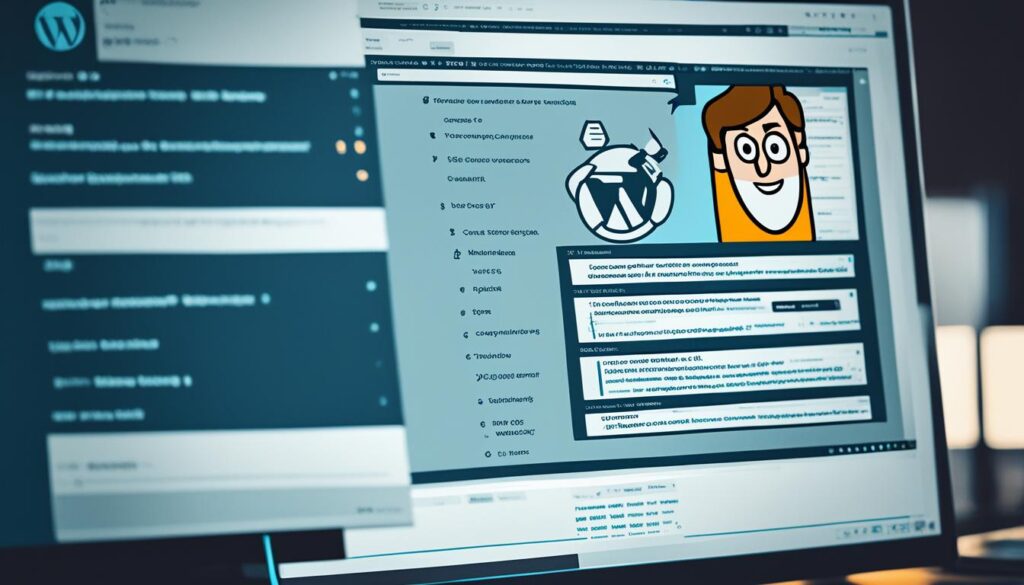Table of Contents
Welcome to our comprehensive guide on how to effectively edit your WordPress theme. Whether you’re looking to make small adjustments or completely transform your site’s appearance, we’ve got you covered. By the end of this guide, you’ll have the knowledge and skills to confidently customize your WordPress theme to suit your unique vision.
Key Takeaways
- Understanding the structure and files of WordPress themes is essential before diving into editing.
- CSS is a powerful tool for customizing various elements of your theme, such as fonts, colors, and layout.
- Modifying theme templates allows you to make more advanced changes to your WordPress theme.
- Using child themes provides a safe way to customize your theme without losing changes during updates.
- Plugins can be used to add new features and functionalities to your WordPress theme.
Understanding WordPress Themes
Before diving into editing, it is important to understand what WordPress themes are and how they work. A WordPress theme is a collection of files that control the overall appearance and functionality of your website.
At its core, a WordPress theme consists of:
- Template files: These define the structure and layout of different pages on your website, such as the homepage, blog posts, and contact page.
- Stylesheet: This file contains the CSS code that determines the visual presentation of your website, including fonts, colors, and spacing.
- Functions.php: This file contains PHP code that adds additional functionality or modifies existing features of your theme.
WordPress themes provide a cohesive design and layout for your website, ensuring consistency across different pages. They allow you to customize the look and feel of your website without altering the underlying structure or code.
Did you know? WordPress offers a vast library of free and premium themes that you can choose from. These themes serve as a starting point for your website’s design, saving you time and effort in creating a custom look from scratch.
With a good understanding of how WordPress themes function, you can now proceed to edit and customize your theme to meet your specific requirements.
Next, we will explore how to customize themes using CSS, allowing you to personalize the appearance of your website even further.
Customizing Themes with CSS
CSS (Cascading Style Sheets) is a powerful tool for customizing the appearance of your WordPress theme. With CSS, you can customize various elements of your theme, including fonts, colors, and layout, to create a website that perfectly aligns with your brand and vision.
“CSS allows you to turn your WordPress theme into a unique and personalized masterpiece. It gives you the flexibility to unleash your creativity and make your website truly stand out.”
Getting Started with CSS Customization
Before you start customizing your theme with CSS, it’s important to understand the structure of your theme’s CSS files. Each WordPress theme has a style.css file that contains the core CSS code for defining the overall website design. You can access this file through the WordPress dashboard or via FTP.
To get started, follow these steps:
- Identify the CSS selector for the element you want to modify. You can use developer tools within your browser to inspect the code and find the appropriate selector.
- Add your desired CSS code to override or modify the existing styles. This can include changes to fonts, colors, borders, spacing, and more.
- Save your changes and refresh your website to see the updated design.
Advanced CSS Techniques for Theme Customization
If you’re comfortable with CSS, there are advanced techniques you can use to take your theme customization to the next level:
- CSS Preprocessors: Consider using CSS preprocessors like SASS or LESS to streamline your CSS workflow and make it more efficient.
- Media Queries: Use media queries to make your theme responsive and ensure it looks great on a variety of devices and screen sizes.
- CSS Frameworks: Take advantage of CSS frameworks like Bootstrap or Foundation to leverage pre-built styles and components for faster and easier customization.
- CSS Animations and Transitions: Add dynamic and engaging effects to your website using CSS animations and transitions.
To help you get started with CSS customization, here’s an example of how you can change the font size and color of your header element:
| CSS Selector | Property | Value |
|---|---|---|
| h1.site-title | font-size | 30px |
| h1.site-title | color | #ff0000 |
Note: Replace “h1.site-title” with the appropriate CSS selector for your theme’s header element. You can adjust the font size and color values to suit your preferences.
By applying CSS techniques, you have the power to fully customize the appearance of your WordPress theme, making it uniquely yours. Experiment, refine, and let your creativity shine through. The possibilities are endless!

Modifying Theme Templates
If you want to make more advanced changes to your WordPress theme, you may need to modify the theme templates. Theme templates are files that control the structure and layout of your website. By editing these templates, you can customize the design and functionality of your WordPress theme to fit your specific needs.
Before diving into modifying theme templates, it is important to understand the structure of a WordPress theme. A typical theme consists of various template files that control different parts of your website, such as the header, footer, sidebar, and individual post/page layouts.
To modify a theme template, you need to locate the specific file you want to edit. WordPress themes usually store their template files in the “wp-content/themes” directory of your WordPress installation. From there, you can navigate to the folder of the theme you are using and find the template file you wish to modify.
Once you have located the template file, you can open it in a text editor and make the necessary changes. It is essential to have a basic understanding of HTML, CSS, and PHP to modify theme templates effectively. If you’re not familiar with these languages, it is recommended to seek the assistance of a professional developer.
When modifying theme templates, it is crucial to exercise caution, as incorrect changes can lead to errors or even break your website. It is always recommended to create a backup of the original template file before making any modifications. This way, you can easily revert back to the original version if something goes wrong.
Remember, modifying theme templates is a powerful way to customize your WordPress theme, but it should be done with care. Make sure to test your changes thoroughly on a staging site before implementing them on your live site to ensure everything functions as expected.
Example: Modifying a Theme Template
Let’s say you want to customize the appearance of your WordPress theme by modifying the header template. You can locate the header template file, usually named “header.php,” in your theme’s folder.
Open the “header.php” file in a text editor and make the desired changes. For example, you can add a logo image or change the layout of the navigation menu.
Once you have made the necessary modifications, save the file and refresh your website to see the changes take effect.
By modifying theme templates, you have the flexibility to transform your WordPress theme to align with your unique vision. However, it’s important to remember that future theme updates may overwrite your modifications. To prevent this, consider creating a child theme, as we will discuss in the next section.
Using Child Themes
Making changes directly to your theme files can be risky, as they may get overwritten during theme updates. To safely customize your WordPress theme without the fear of losing your modifications, child themes are the perfect solution. A child theme is a separate theme that inherits the functionality and styling of its parent theme, allowing you to make customizations while preserving the original theme’s core files.
To create and use a child theme, follow these steps:
- Create a new folder in your WordPress themes directory and name it something memorable and relevant, such as “mytheme-child”.
- In the child theme folder, create a new file called
style.css. - Open
style.cssand add the following code:
/*
Theme Name: MyTheme Child
Theme URI: [Enter your child theme’s URL here]
Description: Child theme for MyTheme
Author: [Your name or company name]
Author URI: [Your website’s URL]
Template: mytheme
Version: 1.0.0
*/
Replace “MyTheme Child” with the name of your child theme, and provide a brief description and your information as necessary. Also, replace “mytheme” in the Template field with the directory name of your parent theme.
Next, you’ll need to enqueue the parent and child theme stylesheets in your child theme’s functions.php file. Open the file in a text editor and add the following code:
function mytheme_enqueue_styles() {
wp_enqueue_style(‘parent-style’, get_template_directory_uri() . ‘/style.css’);
wp_enqueue_style(‘child-style’, get_stylesheet_directory_uri() . ‘/style.css’, array(‘parent-style’));
};
add_action(‘wp_enqueue_scripts’, ‘mytheme_enqueue_styles’);
This code ensures that both the parent and child theme stylesheets are loaded properly.
Now you can start customizing your child theme by adding CSS styles, modifying template files, or adding new functionality through the functions.php file. Any changes you make in the child theme will override the corresponding files in the parent theme.
Example: Modifying CSS in a Child Theme
Let’s say you want to change the color of your site’s headings in the child theme. Open the child theme’s style.css file and add the following CSS:
h1, h2, h3, h4, h5, h6 {
color: #ff0000;
}
This CSS code will make all headings in your child theme appear in red.
Using child themes ensures that your modifications are not lost when you update your parent theme. It provides a safe and efficient way to customize your WordPress theme to suit your specific needs.
Adding Functionality with Plugins
Plugins can greatly enhance the functionality of your WordPress theme. They allow you to easily add new features and capabilities to your site without having to write any code. In this section, we will introduce you to some popular WordPress plugins and show you how to install and configure them to add the desired functionality to your theme.
The beauty of WordPress plugins is that they are designed to be user-friendly, making it accessible for users of all levels of technical expertise. Whether you want to incorporate a contact form, improve your site’s search engine optimization (SEO), or integrate social media sharing buttons, there is likely a plugin available that meets your needs. With thousands of plugins to choose from, you can customize your site to fit your specific requirements.
“Plugins allow you to easily extend the functionality of your WordPress theme, adding new features and capabilities with just a few clicks.” – WordPress Expert
Installing and configuring plugins is a straightforward process. Simply follow these steps:
- From your WordPress dashboard, navigate to the “Plugins” section.
- Click on the “Add New” button.
- Use the search bar to find the desired plugin by entering relevant keywords such as “contact form” or “social media sharing.”
- Once you’ve found the plugin you want, click on the “Install Now” button.
- After installation, click on the “Activate” button to activate the plugin.
- Configure the plugin’s settings according to your preferences. Each plugin will have its own unique settings page where you can customize its behavior and appearance.
- Save your changes and enjoy the added functionality on your site!
Remember to only install plugins from trusted sources, such as the official WordPress Plugin Directory. Additionally, it’s important to keep your plugins up to date to ensure compatibility and security.
With the right combination of plugins, you can transform your WordPress theme into a powerful platform that meets your specific needs. From improving site performance to enhancing user experience, the possibilities are endless. Explore the vast world of WordPress plugins and unlock the full potential of your website!
Conclusion
In conclusion, editing a WordPress theme empowers you to unleash the full potential of your website. Armed with the knowledge gained from this expert guide, you can confidently make changes to your theme, customise its appearance, and enhance its functionality.
Remember to always backup your files and test changes on a staging site before implementing them on your live site. This precaution will ensure that your website remains stable and functional throughout the editing process.
Transforming your WordPress theme to reflect your unique vision is an exciting journey. Enjoy the process of exploring different design options, experimenting with layouts, and optimising your site’s performance. By incorporating your own creativity into every aspect of your website, you will create a captivating online presence that stands out from the crowd.
FAQ
Can I edit my WordPress theme without coding knowledge?
Yes, you can make edits to your WordPress theme without coding knowledge. WordPress provides a user-friendly interface that allows you to customize various aspects of your theme, such as colors, fonts, and layout, through the theme customizer.
What if I want to make more advanced changes to my WordPress theme?
If you want to make more advanced changes to your WordPress theme, such as modifying the theme templates or adding custom functionality, some coding knowledge may be required. However, there are plenty of resources and tutorials available online to guide you through the process.
How do I locate and edit the theme templates?
To locate and edit the theme templates, you can access the theme files through your WordPress dashboard or via FTP (File Transfer Protocol) using a file manager program. Within the theme files, you will find template files such as header.php, footer.php, and single.php, which you can modify to make changes to the overall structure and design of your theme.
What is a child theme and why should I use one?
A child theme is a theme that inherits the functionality and styling of another theme, known as the parent theme. Using a child theme allows you to make modifications to your WordPress theme without directly editing the parent theme files. This is useful because it ensures that your changes won’t be lost during theme updates.
How do I create and use a child theme?
To create a child theme, you need to create a new folder in your WordPress themes directory and provide it with a style.css file that links it to the parent theme. Once the child theme is activated, you can make changes to the theme files, such as modifying templates and adding custom CSS, to customize your theme. The parent theme will serve as the foundation for your child theme.
Can I add new functionality to my WordPress theme?
Yes, you can enhance the functionality of your WordPress theme by using plugins. WordPress offers a vast library of plugins that allow you to add features such as contact forms, image galleries, SEO optimization, and much more. You can easily install and configure plugins through your WordPress dashboard.












